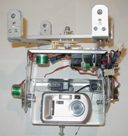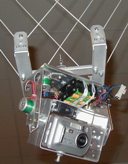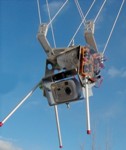Welcome to my Kite Aerial Photography (KAP) Equipment Page
My equipment:
You will find below the description of my KAP rigs.
August 2017 - KAP Rig #6
This time I took a different approach by using 3D printing to make this last KAP rig.
Also, the electronic circuit is now a printed circuit. This has greatly reduced the wiring and consequently reduced the weight of the rig.
All fasteners are made of plastic as well as almost all mechanical components to minimize possible interference with the video transmitter and remote control as well as reduce weight.
Main differences compared to my rig #5:
- Made of 3D printed plastic.
- Reduced wind resistance by adding openings throughout the plastic parts. This has also helped reduce weight.
- Foldable picavet suspension.
- Added a threaded hole under the rig to "park" the 1/4" screw when there is no camera in the rig.
- The video transmitter (5.8GHz, 25mW) and its antenna are fully integrated inside the enclosure.
- The cables to control the camera come out on the side through a large opening. This allowed me to reduce the rig width by as much as 20mm (0.79") and also allows keep the cables connected during transport.
- A new electronic control circuit using an ARM Cortex-M4 microcontroller Texas Instruments (32bits, 80MHz, TM4C123GH6PZ) for more performance and better engine control. The circuit also contains a lot
more options like 3 axis accelerometers, 3 axis gyroscopes, pressure and temperature sensors, On Screen Display (OSD), microSD card, LED indicators.
Similarities to my previous KAP rig:
- Allows you to use a Canon T4i or A590IS camera.
- Takes a picture every 3.5 seconds.
- Uses the same remote control, video transmitter and battery.
See also details during the design discussed on the Kite Aerial Photography (KAP) French and English forums:
6e nacelle sur la table à dessin (French forum)
Yvon's KAP Rig #6 (English forum)
Weight with camera (Canon A590IS): 726g (1.60lbs)
Weight with camera (Canon T4i): 1179g (2.59lbs)
Weight without camera: 476g (1.05lbs)
Photos:







April 2015 - KAP Rig #5
I still use my kap rig #3, especially since I accidentally destroyed my rig #4. Since, I bought
another Canon T4i and I designed a 5th kap rig to replace the one I lost.
This time I took a different approach by using sheets of FR4 fiberglass used for manufacturing
electronic circuit and replacing as much as possible any metal parts by plastic parts to minimize
possible interferences with the video transmitter and the remote control.
Differences from my kap rig #4: Videos
- Almost entirely made of non-metallic parts.
- Miniature DC motors with gear head instead of stepper motors in order to reduce the weight.
- Used timing belts with the motors to reduce the slack in the motion assemblies.
- Video Transmitter (5.8GHz, 25mW) to reduce weight and battery size in addition to eliminating the
necessity to have a Ham Radio license (Canada).
- Replaced the NiMH rechargeable AA batteries by a 0.95mAh LiPo battery to reduce weight and space
used by the batterie.
- New electronic control circuit that uses an ARM Cortex-M4 microcontroller from
Texas Instruments (32bit, 80MHz, TM4C123GH6PM) for more performance and better control of the motors.
- New remote control circuit using Zigbee communication modules from Digi company. I had
started to use these modules with my rig #4 to increase the range of remote control.
- All electronics, battery and motors are inside a closed housing for
better protection, especially during transport.
- Changed the picavet to a square shape rather than a cross to accelerate the installation of the
kap rig on the kite line by reducing the chances that the picavet suspension lines get stuck under the picavet.
Similarities compared to my previous kap rig:
- Allows to use a DSLR Canon T4i or a point & shoot A590IS
- take a photo every 3.5 seconds.
Weight with camera (Canon A590IS): 928g (2.04lbs)
Weight with camera (Canon T4i): 1381g (3.04lbs)
Weight without camera: 682g (1.5lbs)
Photos:











August 2013 - KAP Rig#4
After 5 years since my last kap rig, I finally built a 4th one. I used the same stepper motors as my previous rig
but the electronic control is different and the rig is much larger to fly a bigger camera: Canon T4i.
I can still use my Canon A590IS.
Differences from my previous kap rig:
- Bigger for a Canon T4i camera.
- Video Transmitter (5.8GHz, 200mW) to be able to see what the camera sees
- New electronic control system with remote control. The new circuit is based on an evaluation kit
HHLR-CMD-433-MD where I added a MSP430 microcontroller, two motor control circuits, some output transistors to trigger
the camera and power the video transmitter.
- reduce the play in the pan rotation mechanism
- removed the servo to trigger the camera
- moved batteries
- reduced the size of the picavet
- takes a photo every 3.5 seconds.
Similarities compared to my previous kap rig:
- Same motors
- 4 rechargeable AA NiMH batteries
Weight with camera (Canon A590IS): 929g (2.04lbs)
Weight with camera (Canon T4i): 1406g (3.09lbs)
Weight without camera: 698g (1.54lbs)
Photos:









For the winter, I cover the camera with a little homemade pouch made of felt fabric to isolate it from the cold. When I
tested it at -12C, the camera only took 6 photos without the pouch and 1204 photos when covered with the pouch.



In September 2013, I accidently cut my line as I was bringing my kite down. The kite and the camera crossed a marsh
and the Petitcodiac river (mud and salt water) to land in the marsh on the other side. The aerial photo below shows
the kite trajectory from left to right. The kite and the equipment were found by a friend with his drone about
3 weeks later. The kite is fine but the camera and the kap rig are not working anymore but at least i was able to
get the aerial photos.


December 2008 - KAP Rig#3
I built a third KAP rig. This time I designed and built it myself. The goal was to make a rig lighter than my previous ones and smaller to
make it easier to carry.
I used aluminium of a smaller gauge and the parts are smaller than before. I also changed my camera for a Canon A590 which is 8megapixels.
With this camera, I can take a picture every 5.5 seconds. This new rig can easily be adapted for different cameras.
The pan and tilt motors are 5Volt geared stepper motors. I prefer stepper motors because they consume less power than servo motors.
They are a little more complicated to drive electronically. I designed the electronic circuit based on the Texas Instruments MSP430 microcontroller. The rig
uses four AA NiMH batteries compared to eight batteries in my previous rig. With four batteries, the rig can run for more than 8 hours non-stop
at 5.5 seconds between pictures.
This new rig has two home position sensors, one for each motor. On power up, both motors are brought to their
respective home position and then move to the programmed angles and start taking pictures. The KAP rig is programmed to take pictures by itself
without a remote control. This is called AutoKAP. I usually program the rig to take 16 pictures per turn continuously. It changes the tilt angle
every turn between two pre-programmed angles.
The microcontroller can be programmed with various parameters through a RS-232 serial port on a computer as shown in the example below:
- Number of pictures per cycle: 1 à 99
- Pan angle #1: -360 to +360 degrees (*)
- Pan angle #2: -360 to +360 degrees (*)
- Tilt angle #1: 0 to 90 degrees (**)
- Tilt angle #2: 0 to 90 degrees (**)
- Delay between pictures: 5.5 seconds
(*) When the difference between the two pan angles is less than 360 degrees, the pan motor will rotate back and forth between the
two programmed angles. If the difference is 360 degrees, the pan motor will turn continously one direction.
The angles are always related to the home position.
(**) After each pan cycle, the tilt angle changes between the two programmed angles.
There are more settings that will be possible to programmed soon and the programming will be done by a wireless connection from a
handheld device with a display. This way, the KAP rig can be reprogrammed on the fly if the wind has changed direction or
the kite height has changed for examples.
Weight with camera: 710g (25oz)
Weight without camera: 457g (16oz)
Photos:






Videos:



February 2005 - KAP Rig#2
I built a second KAP rig using aluminium and the help of a friend (thanks to Jean Charles Hébert). I'm still using a Kodak CX7300 3,2megapixel digital camera.
The orientation of the camera is controlled by an electronic circuit with a microcontroller programmed to turn the camera and take a picture every 22,5degrees (16 photos per rotation). After each complete turn, the tilt angle alternate between -30 degrees and -15 degrees from the horizontal. The sequence and movement length can be easily reprogrammed in the software.
The KAP rig uses 8 AA NiMH batteries. The system can take more than 450 photos with the same battery charge and a memory card of 512megabytes.
Weight with camera: 1,48kg (52oz)
Weight without camera: 1,31kg (46oz)
New Functionalities:
- Now uses a servo motor to capture the photos. This permitted to reduce the size of the rig and its weight. Also, the servo motor mechanism is simpler and more reliable than the previous mechanism.
- The tilt rotation is now automatic, which permits to take photos at different tilt angles without bringing down the camera to change the angle.
- The new picavet system eliminates the possibility that the picavet line gets jammed or tangled. This simplifies a lot the installation of the rig to the kite main line.
- The horizontal rotation mechanism is more reliable then the previous one.





June 2004 - KAP Rig#1
I built my first KAP rig using wood. The material and the tools available at the time drove me to use wood for my first prototype. I'm using a Kodak CX7300 3,2megapixel digital camera.
The orientation of the camera is controlled by an electronic circuit with a microcontroller programmed to turn the camera and take a picture every 22,5degrees (16 photos per rotation). The sequence and movement length can be easily reprogrammed in the software.
The tilt angle is adjusted manually before launching the camera. To change the tilt angle, the KAP rig has to be brought down.
The KAP rig uses 8 AA NiMH batteries. The system can take more than 750 photos with the same battery charge and a memory card of 512megabytes.
Weight with camera: 2,36kg (83oz)
Weight without camera: 2,19kg (77oz)






Interesting Web sites:

